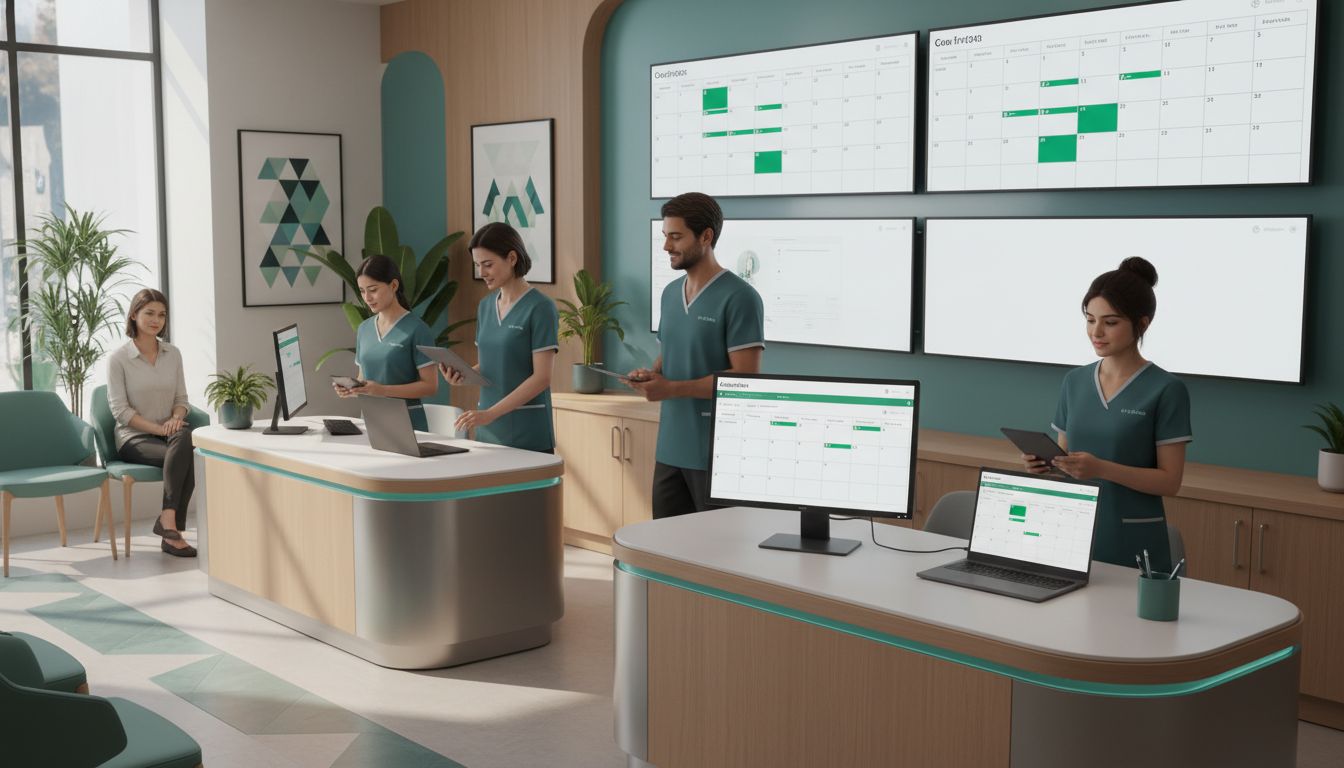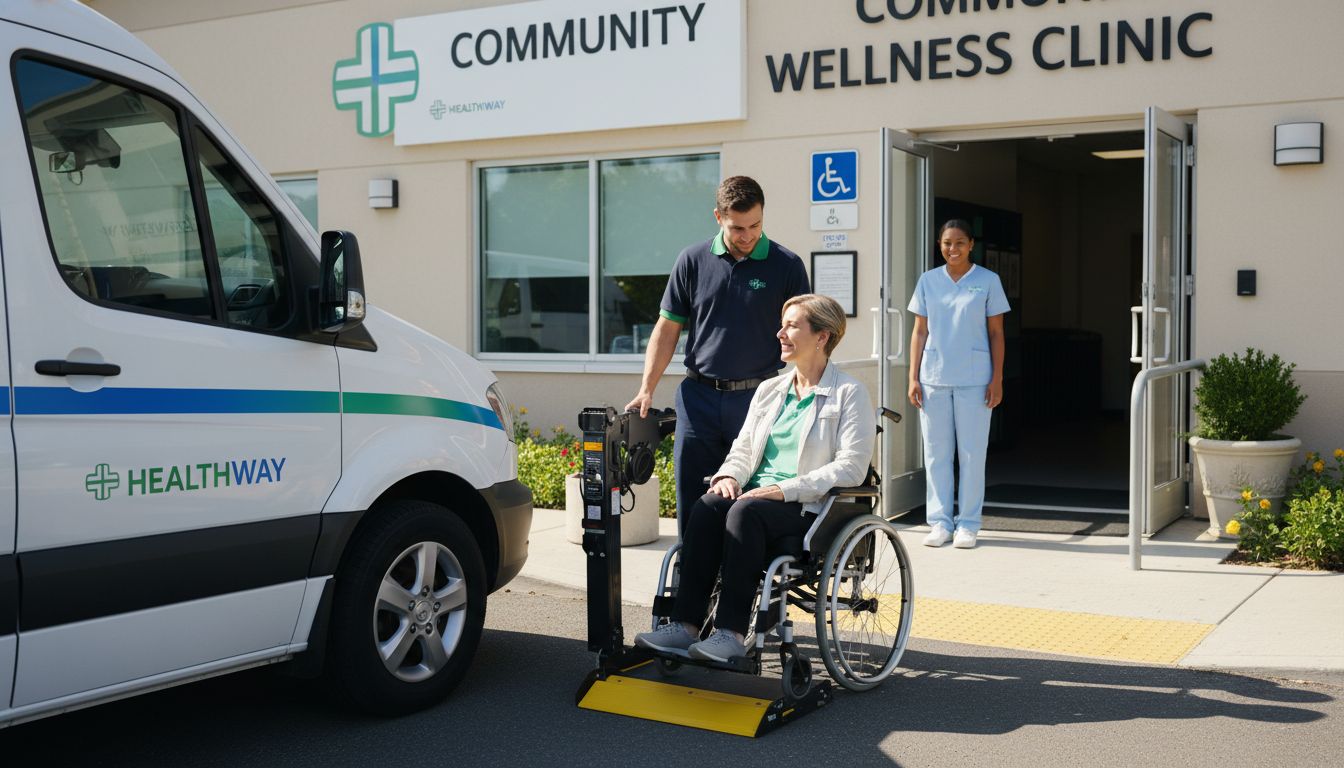What Is Care Coordination? Guide for Providers and Agencies 2025

Care coordination sounds straightforward and you might think it just means doctors and nurses talking to each other. But here is something that might surprise you. Effective care coordination can cut hospital readmission rates by more than 20 percent and slash medical errors in half. Instead of simple teamwork, the real story is about a new web of tech-driven collaboration that changes how patients, families, and entire care teams connect every step of the way.
Table of Contents
- Defining Care Coordination In Modern Healthcare
- Key Roles And Stakeholders In Care Coordination
- Benefits Of Care Coordination For Diverse Services
- Best Practices And Challenges For 2025
Quick Summary
| Takeaway | Explanation |
|---|---|
| Effective Communication is Essential | Establishing clear communication channels among healthcare providers facilitates seamless information exchange about patient status and treatment plans, reducing medical errors and enhancing patient outcomes. |
| Patient-Centered Approaches Improve Care | Developing personalized care strategies that focus on individual patient needs and preferences ensures more effective treatment and better engagement in the healthcare journey. |
| Technological Integration Enhances Coordination | Leveraging advanced digital tools and platforms for real-time information sharing supports more efficient patient management and seamless collaboration among different healthcare services. |
| Comprehensive Care Pathways Mitigate Fragmentation | Creating integrated care plans that connect various healthcare services minimizes gaps in patient care, leading to improved treatment continuity and overall healthcare experiences. |
| Adaptive Strategies Address Emerging Challenges | Healthcare organizations must implement flexible and proactive strategies to navigate complexities such as workforce shortages and rising costs while prioritizing patient-centered care. |
Defining Care Coordination in Modern Healthcare
Care coordination represents a critical healthcare strategy that ensures patients receive comprehensive, efficient, and integrated medical services across multiple providers and settings. At its core, care coordination is a systematic approach to managing patient care that connects healthcare professionals, treatment plans, and patient needs into a cohesive and patient-centered framework.
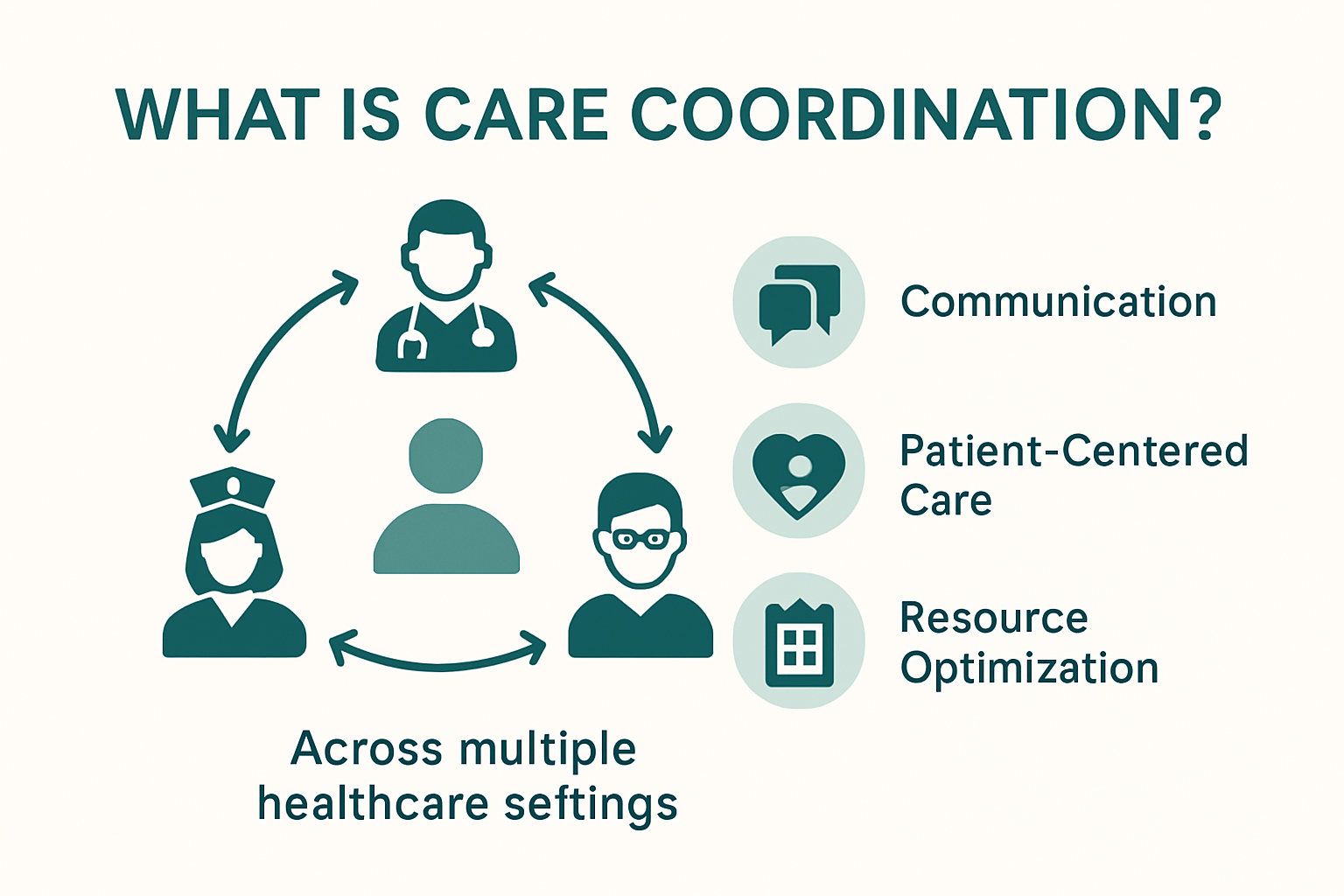
The Fundamental Components of Care Coordination
Understanding care coordination requires examining its essential elements. The Agency for Healthcare Research and Quality defines care coordination as a deliberate organization of patient care activities between two or more participants involved in a patient’s care to facilitate the appropriate delivery of healthcare services. This complex process involves several key components:
- Communication Management: Establishing clear communication channels between healthcare providers, ensuring seamless information exchange about patient status, treatment plans, and medical history.
- Patient-Centered Approach: Focusing on individual patient needs, preferences, and specific health goals while creating personalized care strategies.
- Resource Optimization: Efficiently allocating healthcare resources, reducing redundant services, and minimizing potential gaps in patient care.
The following table summarizes the fundamental components of care coordination and their purposes:
| Component | Purpose |
|---|---|
| Communication Management | Ensures seamless information exchange among providers about patient status, plans, and history |
| Patient-Centered Approach | Focuses on individualized needs and preferences to create personalized care strategies |
| Resource Optimization | Allocates resources efficiently, reduces redundancy, and minimizes care gaps |
Clinical and Operational Significance
Care coordination goes beyond simple communication. Research from the National Academy of Medicine reveals that effective care coordination can significantly reduce medical errors, improve patient outcomes, and lower overall healthcare costs. Healthcare systems implementing robust care coordination strategies experience substantial improvements in patient safety, treatment continuity, and operational efficiency.
The complexity of modern healthcare demands a sophisticated approach to patient management. Chronic disease management, complex medical conditions, and an increasingly aging population require intricate coordination between primary care physicians, specialists, hospitals, rehabilitation centers, and home health services. Care coordination acts as a critical bridge, ensuring that patients receive holistic, integrated care that addresses their comprehensive health needs.
Moreover, care coordination is not just a clinical strategy but a transformative approach that addresses systemic healthcare challenges. By creating comprehensive, patient-centered care pathways, healthcare providers can reduce fragmentation, minimize unnecessary medical interventions, and create more personalized treatment experiences.
Key considerations for effective care coordination include developing clear communication protocols, leveraging technology for information sharing, establishing standardized assessment tools, and creating collaborative care teams that prioritize patient-specific needs. These elements work together to create a comprehensive framework that supports patients through their entire healthcare journey.
As healthcare continues to evolve, care coordination will become increasingly vital in delivering high-quality, efficient, and patient-centered medical services. Its role in transforming healthcare delivery cannot be overstated, representing a fundamental shift towards more integrated, responsive, and compassionate medical care.
Key Roles and Stakeholders in Care Coordination
Care coordination involves a complex network of healthcare professionals and organizations working collaboratively to deliver comprehensive patient care. Understanding the diverse roles and stakeholders is crucial for creating an effective and integrated healthcare delivery system.
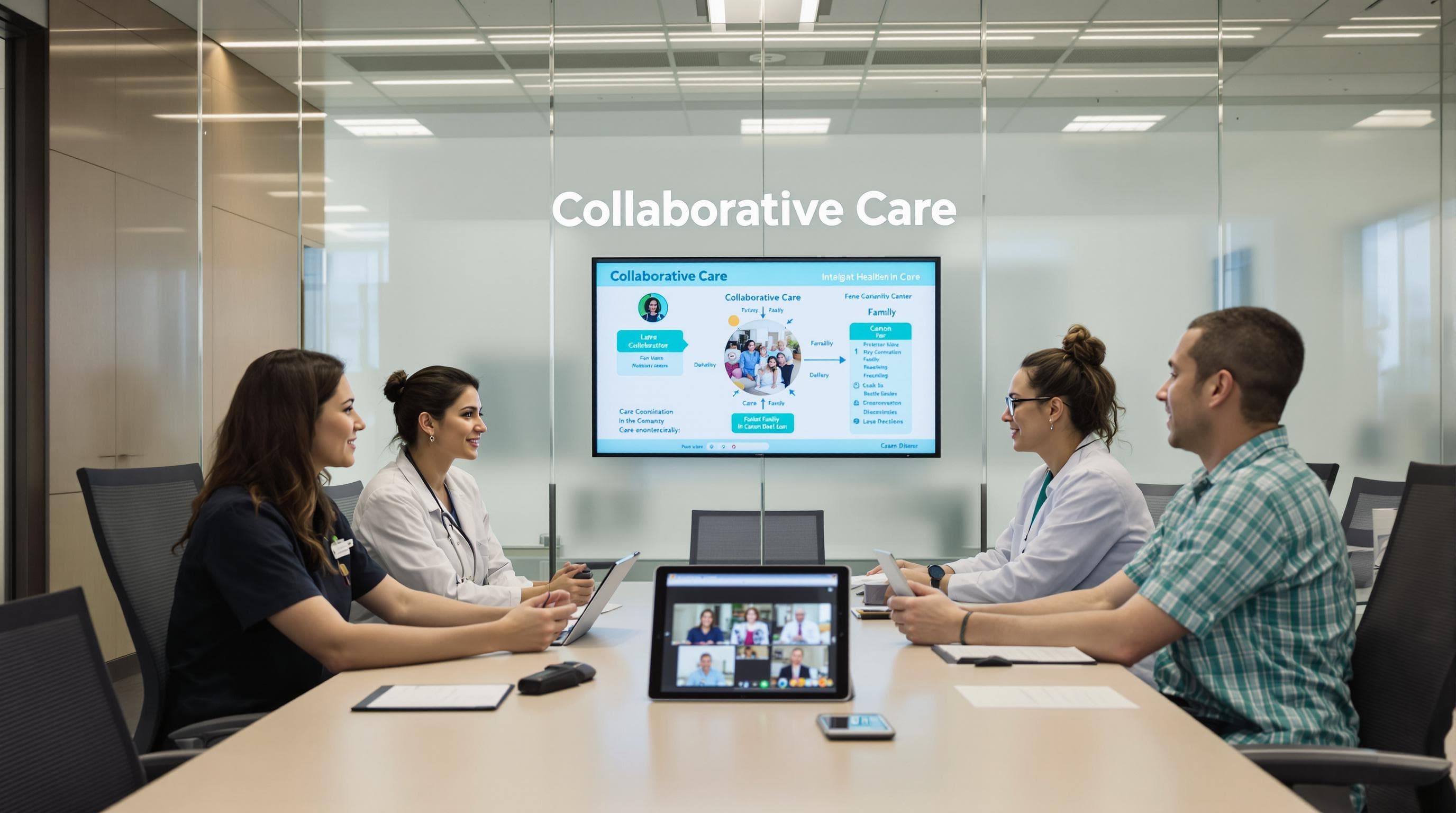
Primary Healthcare Providers and Professionals
The American Hospital Association highlights that successful care coordination requires active participation from multiple healthcare professionals. Primary care physicians serve as central coordinators, synthesizing patient information and guiding overall treatment strategies. Specialists play critical roles in providing targeted expertise for specific medical conditions, ensuring patients receive comprehensive and nuanced care.
Nurses and nurse practitioners are pivotal stakeholders in care coordination. They often serve as critical communication links between patients, physicians, and other healthcare providers. Their direct patient interactions and comprehensive understanding of patient needs make them essential in managing complex care pathways.
- Primary Care Physicians: Central coordinators of patient care
- Specialists: Provide targeted medical expertise
- Nurses and Nurse Practitioners: Communication and patient management experts
Organizational and Institutional Stakeholders
Research from the National Center for Biotechnology Information reveals that effective care coordination extends beyond individual professionals to include entire healthcare organizations and systems. Hospitals, clinics, rehabilitation centers, home health agencies, and long-term care facilities must collaborate seamlessly to ensure comprehensive patient care.
Each organizational stakeholder brings unique capabilities and resources to the care coordination process. Hospitals provide acute and specialized medical services, while home health agencies ensure continuous care and support during recovery. Rehabilitation centers focus on patient recovery and functional restoration, creating a comprehensive ecosystem of healthcare services.
Insurance providers and payers also play significant roles in care coordination. They help manage financial aspects, authorize treatments, and support care management strategies that optimize patient outcomes while controlling healthcare costs.
Emerging Roles and Technology-Enabled Coordination
The landscape of care coordination is rapidly evolving with technological advancements. Care coordinators and patient navigators are emerging as specialized professionals who leverage digital tools to streamline communication, track patient progress, and ensure seamless transitions between different care settings.
Technology platforms now enable real-time information sharing, allowing stakeholders to collaborate more effectively. Electronic health records, telehealth solutions, and integrated communication systems have transformed how healthcare professionals coordinate patient care, making the process more efficient and patient-centered.
Patients and their families are increasingly recognized as active participants in care coordination. Their insights, preferences, and direct involvement are crucial for creating personalized and effective care strategies. This patient-centered approach ensures that care coordination reflects individual needs and promotes better health outcomes.
As healthcare continues to become more complex and interconnected, the roles and stakeholders in care coordination will continue to evolve. The future demands flexible, technology-enabled, and patient-focused approaches that prioritize comprehensive, collaborative healthcare delivery.
The table below summarizes the key stakeholders involved in care coordination and their primary responsibilities:
| Stakeholder | Primary Responsibility |
|---|---|
| Primary Care Physicians | Central coordination and oversight of patient care |
| Specialists | Provide targeted expertise for complex conditions |
| Nurses & Nurse Practitioners | Manage communication and daily patient needs |
| Hospitals & Healthcare Facilities | Provide acute and specialized medical services |
| Rehabilitation & Home Health Agencies | Support patient recovery and functional restoration |
| Insurance Providers/Payers | Manage financial aspects and authorize treatments |
| Care Coordinators/Patient Navigators | Streamline communication and manage care transitions |
| Patients & Families | Actively participate and provide input for personalized care |
Benefits of Care Coordination for Diverse Services
Care coordination delivers transformative advantages across multiple healthcare service domains, creating substantial improvements in patient outcomes, operational efficiency, and overall healthcare delivery. By systematically connecting different medical services, care coordination addresses critical challenges in modern healthcare systems.
Enhanced Patient Outcomes and Experience
The Agency for Healthcare Research and Quality demonstrates that comprehensive care coordination significantly improves patient health results. Patients experiencing coordinated care receive more personalized, comprehensive treatment strategies that address their unique medical needs.
Key benefits for patients include:
- Reduced Medical Errors: Minimizing communication gaps between healthcare providers
- Improved Treatment Continuity: Ensuring consistent and comprehensive medical interventions
- Personalized Care Pathways: Developing targeted treatment approaches
Specifically, care coordination helps patients with chronic conditions manage complex health requirements more effectively. By creating integrated care plans, healthcare providers can track patient progress, adjust treatments promptly, and prevent potential complications.
Operational Efficiency and Cost Management
Research from the Healthcare Financial Management Association reveals that effective care coordination can generate substantial financial benefits for healthcare organizations. By reducing redundant medical services, minimizing unnecessary interventions, and optimizing resource allocation, healthcare systems can significantly lower operational costs.
Operational advantages include:
- Streamlined administrative processes
- Reduced hospital readmission rates
- More efficient utilization of medical resources
- Improved insurance claim management
Healthcare providers implementing robust care coordination strategies can decrease overall system expenses while maintaining high-quality patient care. This approach transforms care delivery from a fragmented model to a more integrated, patient-centered system.
Technological Innovation and Service Integration
Modern care coordination leverages advanced technologies to create seamless service connections. Digital platforms enable real-time information sharing, allowing different healthcare services to communicate efficiently and effectively. Electronic health records, telehealth solutions, and integrated communication systems play crucial roles in this transformation.
Emergent technological capabilities support care coordination by:
- Facilitating secure information exchange
- Enabling remote patient monitoring
- Supporting predictive health analytics
- Creating comprehensive patient health profiles
These technological innovations help healthcare services move beyond traditional boundaries, creating more responsive and adaptive care ecosystems. By integrating diverse medical services through advanced coordination strategies, healthcare providers can offer more comprehensive, patient-focused treatment approaches.
As healthcare continues evolving, care coordination will become increasingly critical. It represents a fundamental shift from fragmented, service-specific models to holistic, interconnected healthcare delivery. The ability to effectively coordinate services across different medical domains will define the future of patient care, emphasizing comprehensive, efficient, and personalized healthcare experiences.
Best Practices and Challenges for 2025
As healthcare continues to evolve, care coordination faces complex challenges and opportunities in 2025. Navigating these dynamics requires strategic approaches that balance technological innovation, patient needs, and organizational capabilities.
Technological Integration and Digital Transformation
The Healthcare Information and Management Systems Society emphasizes that successful care coordination in 2025 demands robust technological infrastructure. Healthcare organizations must prioritize interoperable digital systems that enable seamless information exchange and real-time communication across diverse medical services.
Key technological best practices include:
- Comprehensive Electronic Health Records: Developing unified patient information platforms
- AI-Powered Predictive Analytics: Utilizing machine learning for proactive care management
- Secure Cloud-Based Communication Systems: Enabling instant, protected information sharing
Healthcare providers must invest in advanced digital solutions that support comprehensive care coordination, ensuring data accuracy, privacy, and accessibility across different medical settings.
Patient-Centered Coordination Strategies
The Institute of Medicine recommends patient-centered approaches as critical best practices for 2025. This involves creating personalized care pathways that actively engage patients in their healthcare journey, emphasizing transparency, communication, and individual preferences.
Effective patient-centered coordination requires:
- Developing personalized communication protocols
- Implementing patient feedback mechanisms
- Creating accessible health information platforms
- Training healthcare professionals in patient engagement techniques
The goal is to transform care coordination from a purely clinical process to a collaborative, empowering experience that respects patient autonomy and individual health goals.
Emerging Challenges and Strategic Responses
Healthcare organizations will confront significant challenges in implementing comprehensive care coordination strategies. These include managing increasing healthcare complexity, addressing workforce shortages, and adapting to rapidly changing technological landscapes.
Critical challenges for 2025 include:
- Integrating diverse medical technologies
- Managing rising healthcare costs
- Addressing healthcare professional burnout
- Ensuring consistent care quality across different service providers
Successful healthcare organizations will develop flexible, adaptive strategies that can quickly respond to emerging technological and systemic changes. This requires creating organizational cultures that prioritize continuous learning, technological innovation, and patient-centered care.
The future of care coordination demands a holistic approach that balances technological capabilities, human expertise, and patient needs. By anticipating challenges and implementing forward-thinking strategies, healthcare providers can create more responsive, efficient, and compassionate care coordination systems that truly improve patient outcomes and healthcare experiences.
Frequently Asked Questions
What is care coordination?
Care coordination is a systematic approach to managing patient care that ensures comprehensive, efficient, and integrated medical services across multiple providers and settings. It connects healthcare professionals and treatment plans into a cohesive, patient-centered framework.
Why is care coordination important?
Effective care coordination can significantly improve patient outcomes by reducing medical errors, enhancing treatment continuity, and lowering healthcare costs. It fosters seamless communication among healthcare providers, leading to better health management and patient experiences.
Who are the key stakeholders in care coordination?
Key stakeholders include primary healthcare providers like physicians, specialists, nurses, and nurse practitioners, as well as healthcare organizations, rehabilitation centers, home health agencies, insurance providers, and patients and their families. Each plays a vital role in delivering integrated patient care.
How can technology enhance care coordination?
Technology enhances care coordination by enabling real-time information sharing through electronic health records, telehealth solutions, and integrated communication systems. These tools streamline collaboration among healthcare providers and improve the efficiency of patient management.
Transform Care Coordination With VectorCare’s Modern Platform
If fragmented communication and manual processes are slowing down your care coordination, you are already feeling the impact on patient outcomes and operational costs. The article highlights how mismanaged patient logistics and lack of real-time collaboration can lead to higher readmission rates and missed care opportunities. Are you searching for a proven way to deliver seamless, efficient healthcare across teams and services?
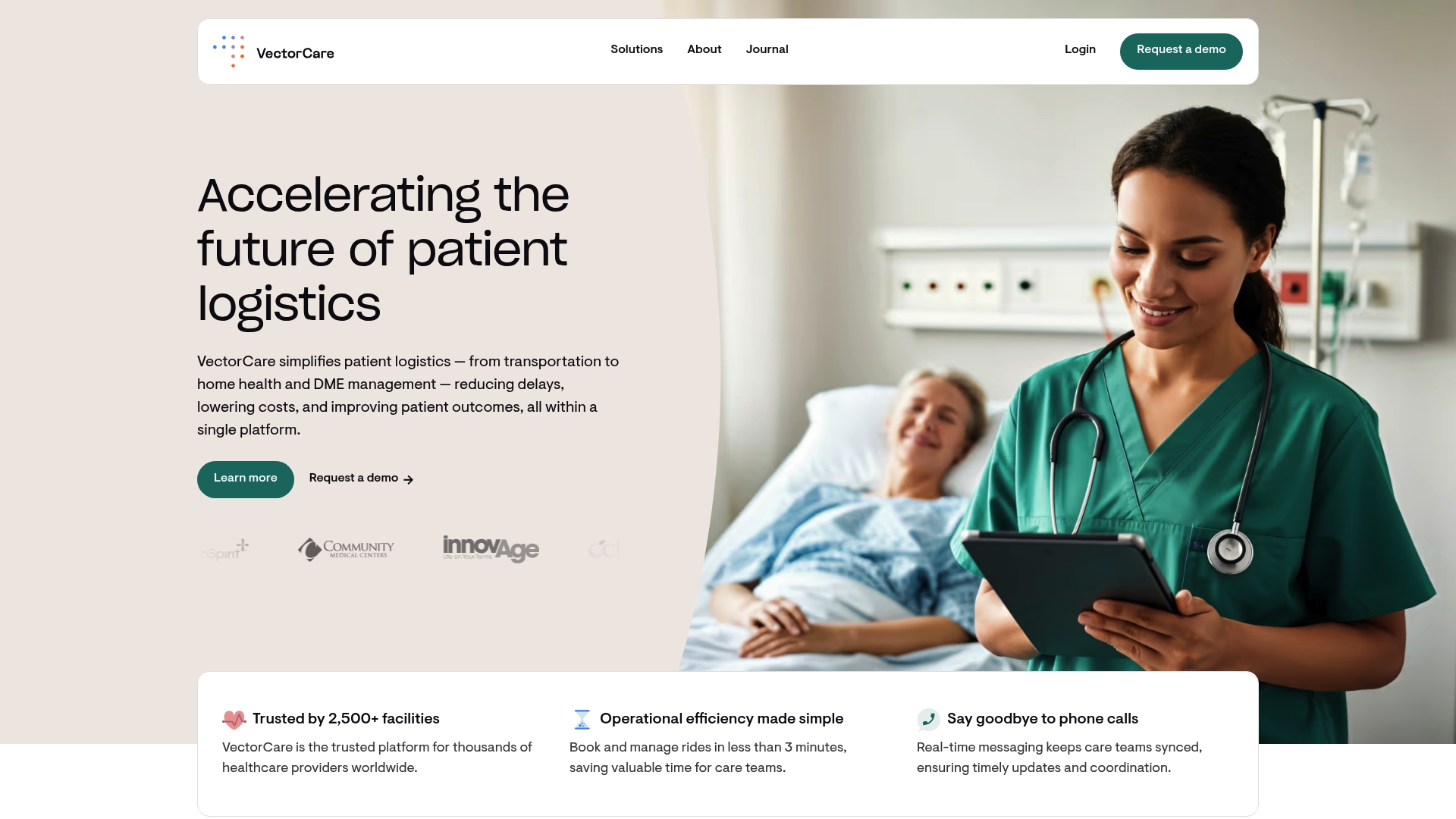
Let VectorCare be your solution for turning best practices into everyday results. Our comprehensive digital platform automates scheduling, enhances secure communication, and connects all stakeholders through one intuitive hub. Experience reduced delays, lower costs, and improved patient journeys. Start streamlining your care coordination today and see measurable improvements with VectorCare’s integrated platform. Ready to eliminate inefficiency and drive better patient outcomes? Visit https://vectorcare.com to see how you can take your care coordination to the next level now.
